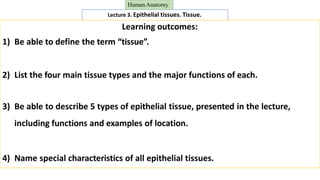
Lec 3 Epithelial tissues.pptx
- 1. Lecture 3. Epithelial tissues. Tissue. HumanAnatomy Learning outcomes: 1) Be able to define the term “tissue”. 2) List the four main tissue types and the major functions of each. 3) Be able to describe 5 types of epithelial tissue, presented in the lecture, including functions and examples of location. 4) Name special characteristics of all epithelial tissues.
- 2. A tissue is an ensemble of similar cells from the same embryonic origin that together carry out a specific function. Be able to define the term “tissue”. Histology (‘histo’ meaning ‘fabric’) is the study of the microscopic structure of tissues. Marie François Xavier Bichat (14 November 1771 – 22 July 1802) was a French anatomist and pathologist; he is known as the father of histology. Although working without the microscope, Bichat distinguished 21 types of elementary tissues from which the organs of human body are composed.
- 3. List the four main tissue types and the major functions of each. Typical functions of Connective tissue: protects, supports, connects or separates different types of tissues and organs. Functions of Muscle tissue provides posture and body support, locomotion and heat production. Functions of the nervous system: sensory input, integration, control and regulation of muscles and glands, homeostasis, and mental activity. Functions of epithelial tissues: secretion, absorption, filtration and protection.
- 4. • Blood
- 5. Diversity of tissue types
- 6. Based on number of layers. Based on cell’s shape. Epithelial tissues (epithet means covering) line body surface, the cavities and surfaces of blood vessels and organs throughout the body; including glands. Epithelial tissues lies on basement membrane – “glue”-like substances produced by fibroblasts of connective tissue to hold cells together. Be able to describe 5 types of epithelial tissue, including functions and examples of location.
- 7. 5 types of epithelial tissue
- 8. Simple involved in absorption, secretion and filtration. Microvilli are projections of cell body, function: increase surface area. Stratified involved in protection. Microvilli Cilia skin, mouth, esophagus, nose, vagina alveolar, capillaries kidney tubules, glands Psedo means false trachea small and large intestine ducts of large glands ducts of large glands Ciliated moves mucus or reproductive cells.
- 9. Simple squamous • Lines blood vessels and air sacs of lungs. • Permits exchange of nutrients, wastes, and gases Simple cuboidal • Lines kidney tubules and glands. • Secretes and reabsorbs water and small molecules. Simple columnar • Lines most Digestive organs. • Absorbs nutrients, produces mucus. Secretory (Goblet) cell Stratified cuboidal Stratified columnar • Outer layer of skin, mouth, vagina. • Protects against abrasion, drying out, infection. • Lines ducts of sweat glands. • Secretes water and ions. • Lines epididymis, mammary glands, larynx. • Secretes mucus. Basement membrane Stratified squamous keratinized or nonkeratinized Most epithelial tissues line or cover surfaces or body cavities.
- 10. Alveoli
- 11. Capillary
- 12. Blood vessels
- 13. Kidney
- 15. Secrete oil Secrete sweat
- 16. Gland Epithelium of thyroid gland
- 17. intestine
- 18. intestine
- 19. skin keratinized
- 22. Stratified Cuboidal Epithelium Description: 2 to 3 layers of cube-shaped cells Function: Protection Location: Linings of ducts of mammary glands, sweat glands, salivary glands, and pancreas
- 23. Pseudostratified Columnar Epithelium Description: Single layer, nuclei are uneven which gives it a layered appearance. Have ciliated cells and secretory goblet cells which secrete mucus. Location: trachea, tubes of reproductive system. Ciliated cells Goblet cells Connective tissue
- 25. Bulbar conjunctiva; the epithelial cells become cylindrical when they reach the surface. Note the abundant goblet cells. Stratified columnar epithelium
- 26. The conjunctiva is a thin, semitransparent mucous membrane that covers the posterior surface of the eyelids and is then reflected onto the eyeball.
- 27. Transitional Epithelium is a highly modified, stratified squamous epithelium that forms the lining of only a few organs: urinary bladder, ureters and part of urethra. All of these organs have ability to stretch. When these organs filled with urine, appearance of epithelium change to thin and with squamous-shape cells.
- 28. transition Empty Full Epithelial tissue of Urinary bladder stretched
- 32. Sweat and Salivary glands Oil glands
- 33. Mammary gland Sweat and Salivary glands Oil glands
- 35. Goblet cells – mucus secreting unicellular glands. Microvilli – extension of the cell, function increase surface area of absorption epithelial cells in intestine.
- 37. Can be keratinized and nonkeratinized.
- 39. Special characteristics of all epithelial tissues: 1)Epithelial cells are tightly packed, closely connected to each other. 2)Epithelial cells lies on the basement membrane. 3)Epithelial tissue – avascular, lack blood vessels.
- 40. 1) Be able to define the term “tissue”. 2) List the four main tissue types and the major functions of each. 3)Be able to describe structure of 5 types of epithelial tissue, including functions and examples of location. Active Learning
- 42. B C D E F G H I